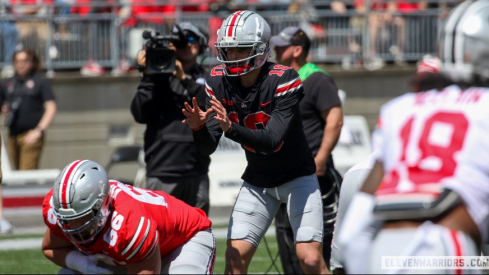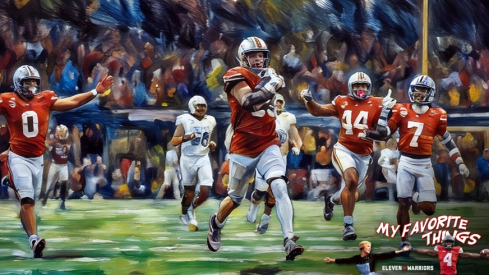
As I continue my season in review I'm going to take a slightly different tack and break down the Buckeyes' offensive personnel by position. Today, I will analyze the OSU offensive line—both in their 2012 performance and what it may portend for 2013.
Cohesion is the Name of the Game
With three new starters at four new positions, the Buckeye line was the biggest question mark entering 2012. Urban Meyer made no secret during spring practice that he was disappointed in that unit's performance.
Yet the starting five of (L-R) Jack Mewhort, Andrew Norwell, Corey Linsley, Marcus Hall, and Reid Fragel became the glue of the Ohio State offense and perhaps the team's most consistent position group. Credit goes to the players as well as offensive line coach Ed Warinner, who melded this group together into a more physical, aggressive, and cohesive unit.
Behind this unit OSU employed one of the most effective run games in the country, even though opposing defenses often knew it was coming. What made the Buckeye line so effective was how well they worked together as a unit in the Buckeyes' zone blocking game. It was thus apropos that the Buckeyes capped off their undefeated season by gaining a first down on 3rd and 7 running power left behind that Buckeye O-line.
Causation and Correlation
Concededly, the line was at times inconsistent in pass protection, particularly in identifying and picking up zone blitzes.
Yet those blitz issues were at times a result of using 4 and 5 receiver formations. In those situations, a quarterback has to be prepared to unload the football quickly. This is symptomatic of the fact that that Braxton Miller was primarily responsible for OSU's relatively high sack total. Generally speaking, a quarterback has 4-6 seconds to throw the football before becoming responsible for difficulties resulting from defensive pressure.
Yet Miller often held the football too long, sitting in the pocket rather than using his athletic ability to create time and/or yards.
OSU would thus have negative pass plays even when the offensive line provided adequate protection. Pressure issues were thus a reflection of an inconsistent passing game, but cannot solely be laid upon the offensive line.
Grindin'
The OSU offensive line was at its strength, however, running between the tackles. Generally speaking, the Buckeye offensive line controlled opposing defensive fronts throughout the season. This was of course assisted by OSU cancelling out one defender by reading him and forcing a defense to account Miller.
Even so, as long as OSU could get a somewhat even matchup numbers-wise up front, they could create movement at the point of attack. The Buckeye line was effective because they worked well as a cohesive unit, creating movement on base zone runs through double teams and then coming off onto second level defenders.
I have made no secret that OSU was a left-handed run team all year. When in doubt they were going to run inside zone at the backside A gap behind Mewhort and Norwell.

This is reflective of the fact that both Mewhort and Norwell played at an all-league level. Mewhort was agile at his left tackle position, adapt at coming off combo blocks to the second level. Norwell is a mauler. He plays with a nasty disposition and blocks to the whistle. Together they make a very effective combination.
The third critical component of this left-handed tendency was Corey Linsley. Meyer often discusses the importance of the center as the 'apex' of the offensive line and the offense as a whole, and Linsley was able to fill this position ably. Linsley plays with much the same attitude as Mewhort. He was also quick in his first step, enabling him to successfully execute reach blocks.
Linsley's play was indisputably hampered, however, by the severe ankle sprain he suffered late in the season. This was noticeable even in his shotgun snaps, which had previously been largely flawless. Yet it was clear that Linsley was worried about executing his zone steps with his bad ankle and accordingly rushed the snap, resulting in broken plays. Putting this aside, Linsley made significant improvements at a position he had not played and was critical to the Buckeyes' success.
What made OSU an effective offensive line, though, was that despite being left-handed, there was little drop-off on the right side of the offensive line, and OSU was able to effectively run the football either way. Marcus Hall was probably the most inconsistent of the OSU's starting offensive linemen but this was alll relative.
Hall struggled at times with quick interior defensive linemen and had better games than others. Yet he improved as the season progressed and played his best football in November. Hall was also perhaps OSU's most effective pulling lineman. This contributed to the Buckeye offense's left-handedness, as they also liked running power plays left behind Hall.
Finally, the emergence of Reid Fragel at right tackle was a critical yet often overlooked aspect of the Buckeyes' ability to go undefeated. Even though Fragel has the prototypical size and frame to play tackle, it was always going to be a difficult transition for a senior to make after three years at tight end. The bumpiness of this transition was emphasized by Meyer after the Buckeyes' initial contests.
But to his credit, Fragel quickly adapted once he was able to get game experience and subsequently performed at a high level. He was able to use his athleticism to be effective, particularly in space against edge defender. In that sense, his coming out party was controlling William Gholston in Ohio State's game-sealing drive against Michigan State.
Fragel acquitted himself well in his first season at the position and has a high ceiling going forward, given his size and feet.
One Spot
Expectations are high for OSU's offense in 2013 and a large part of that optimism is that the Buckeyes return four starters from this superb unit. Fragel is the only departing senior and the most likely to fill his spot is Taylor Decker. Decker was briefly discussed as a potential starter at right tackle as a true freshman before the season, and Meyer touted his progressed late in the season. Like Fragel, Decker has the prototypical tackle build and looked fairly solid in limited action. His emergence will go a long way towards solidifying the Buckeye offensive line.
This is particularly important because the Buckeye offensive line is otherwise extremely thin. As Meyer emphasized this fall, the Buckeyes had essentially five offensive linemen they could rely upon. Fortunately for OSU, those five constituted perhaps the conference's best unit and none battled significant injuries other than Linsley's ankle. Meyer did feel, however, that Decker and Chase Farris emerged as capable backups by mid-season.
Farris is an interesting case. A converted defensive lineman, Farris has the athleticism you would expect from one making that transition. He worked at the right guard position this year and Meyer's continued praise led some to wonder whether he could push Hall for playing time. I find that unlikely given how Hall finished the season, but Decker and Farris give the Buckeyes competition and options as to how Warinner will fill that open slot.
Given Warinner's results this season and how Meyer likes to push his offensive linemen, expect an even better unit next season.

